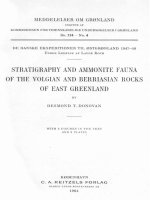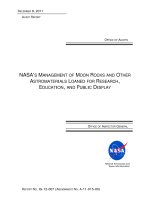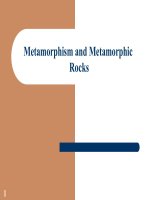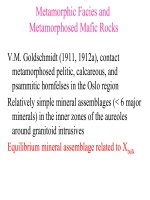Metamorphic rocks
Bạn đang xem bản rút gọn của tài liệu. Xem và tải ngay bản đầy đủ của tài liệu tại đây (2.87 MB, 20 trang )
THE LANGUAGE OF THE
EARTH – PART III
METAMORPHIC
ROCKS
Rock Cycle
Definition
Metamorphism- changes in the mineral assemblage and
textures of igneous, sedimentary or other metamorphic
rocks due to prolonged exposure to elevated temperatures
and pressures (or increased grades of metamorphism)
Types of Metamorphism
1) Burial metamorphism (also known as Diagenesis or Lithification) - Low
T, low-mod confining to differential P; original sedimentary/igneous
features generally preserved; forms in deeper parts of thick sedimentary
sequences in non-tectonic area (e.g., on passive continental margins)
Types of Metamorphism
2) Contact (or Thermal) metamorphism - High T, low-mod.
confining P; forms adjacent to igneous intrusions.
Types of Metamorphism
3) High-pressure metamorphism - High P (strongly
differential), low-mod T; forms at plate boundaries
convergent boundary zones. Also know as blueschist
metamorphism.
Types of Metamorphism
4) Regional metamorphism -Variable T, mod-high differential P;
characteristic of over-thickened plates (i.e., mountain belts)
above convergent boundaries; affects large areas
Types of Metamorphism
5) Cataclasis metamorphism -Variable T, very high directed P;
typically localized to narrow zones of intense mechanical
deformation (shear zones).
Types of Metamorphism
6) Metasomatism -Variable T&P; distinguished from other forms of
metamorphism by the loss and/or gain of material (usually
transported by a fluid). Other types of metamorphism are thought
to occur as nearly closed processes (except for water loss).
Controls on Rates of Metamorphic Change
•
•
•
Fluid content (particularly water) of
the rock. Water helps to catalyze the
mineral transformations. Water gets
“baked” out of rocks during prograde
metamorphism.
Temperature - chemical reactions
occur faster at higher temperatures.
Time - For a rock to develop a new
metamorphic mineral assemblage
corresponding to a particular P & T, it
must exist under those condition for a
sufficiently long period of time
(generally tens of thousands to
millions of years).
Why do we see high grade metamorphic rocks at the
earth’s surface?
Isostatic
Rebound
“Rapid” erosion of
mountain belts of
“dry” rocks
Mineralogic Response to
Metamorphism
Minerals that form depend on:
• T and P conditions
• Bulk composition of the source
rock
Progressive
metamorphism
of a graywacke
(dirty sandstone)
Textural Response to Metamorphism
Reflects the intensity and directionality of pressure (or stress).
• Increased grain size - During prograde metamorphism or at a particular grade that is
maintained for a long period of time, minerals will tend to increase in size.
• Foliation - As new platy minerals grow, they will align themselves perpendicular to the
maximum stress direction. For clay mineral and fine-grained micas, the planar fabric that
results is referred to as a slaty cleavage. In higher grade rocks, coarser grained mica
minerals are said to impart a schistosity to the rock.
• Gneissic Banding - In very high grade rocks, the dark minerals tend to segregate from the
lighter colored minerals (feldspar and quartz) resulting in banded rock..
Development of Foliation in Bedded Sedimentary Rocks
Other Textural Responses
Porphyroblasts
Some metamorphic minerals have strong growth habits, meaning they
will develop as large well-formed crystals called porphyroblasts
Alkali Feldspar
Staurolite
Garnet
Textural Response to Thermal Metamorphism
Granoblastic Texture
Creates a very dense,
granular, fine-grained
mineral texture called
granoblastic texture
Metamorphic rocks
displaying granoblastic
texture are called
hornfels
basaltic hornfels
sedimentary hornfels
Summary of
Metamorphic
Rock Types
STRUCTURAL DEFORMATION
Large-scale Response to Directed Pressure
Dependent on Temperature and Rate of Stress
High Temperature, Low Rate of Stress → FOLDING
STRUCTURAL DEFORMATION
Large-scale Response to Directed Pressure
Low Temperature, Rapid Rate of Stress → FAULTING
Rock Cycle
Limestone
Qtz Sandstone
Graywacke
Shale
Quartzite
Slate Marble
Quartz + Clay+Lithics
Clay+Lithics
Basalt
Rhyolite
Greenstone
Gabbro
Granite
Amphibolite
Felsic
Mafic
Migmatite
Schist
Gneiss









